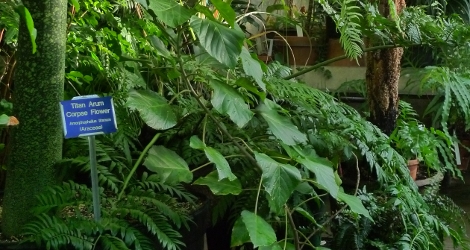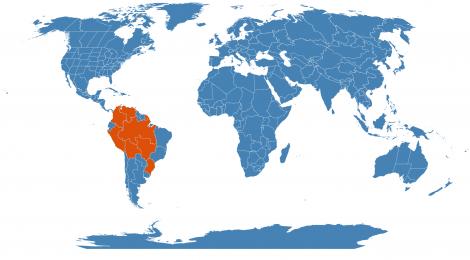Accession Data:
Hevea brasiliensis (Willd. ex A.Juss.) Müll.Arg.
- Common Name: Para Rubber Tree
- Family: Euphorbiaceae Juss.
- Synonym(s): Siphonia brasiliensis Willd. ex A.Juss.
- Description: This tree reaches 120 ft (36 m) in its natural habitat along the Amazon and Orinoco rivers in South America but elsewhere it seldom exceeds 60 ft (18 m). The thick, leathery leaves are divided into 3 leaflets and the greenish white perfumed flowers are insignificant. These flowers appear before or with new growth, which is a distinctive bronze-purple. It is rarely grown other than in commercial plantations or in botanical gardens.
- Uses: In Brazil used for an insect repellant and soap.
- IMPORTANT NOTE: Plant Uses are for informational purposes only. EEB Greenhouses assume no responsibility for adverse effects from the use of any plants referred to on this site. Always seek advice from a professional before using any plant medicinally.
- Culture: Tropical heat and humidity are essential to the commercial cultivation of these trees, although they will survive in large heated greenhouses where they should be pruned in late winter to restrict size and maintain a neat shape. They need moist, free-draining soil and part-shade in the heat of summer. Propagate from fresh seed.
- USDA Zone: 11-12
Accession Data:
- Accession # 200202487
- Source: Marcia Kirinus - Duke
- Provenance:
Duke Acc#02-090 Plants recieved at Duke from Tom Hecker (Butterfly Conservatory) who recieved seed from Malaysia and grew them on.
- Accession Date: 11-18-2002
- Bench: 1310 - NEOA: Ground Bed 2 NW
- Currently: active - healthy
- Qty: 1 confirmed on 10-08-2024
Classification:
- Division: Magnoliophyta
- Class: Magnoliopsida
- SubClass: eurosid I
- Order: Malpighiales
- SubOrder:
- Family: Euphorbiaceae
- SubFamily: Crotonoideae
- Tribe: Micrandreae
- SubTribe: Heveinae
Flowering Data:
This accession has been observed in bloom on:| Year | Jan | Feb | Mar | Apr | May | Jun | Jul | Aug | Sep | Oct | Nov | Dec | ||||||||||||||||||||||||||||||||||||||||
|---|---|---|---|---|---|---|---|---|---|---|---|---|---|---|---|---|---|---|---|---|---|---|---|---|---|---|---|---|---|---|---|---|---|---|---|---|---|---|---|---|---|---|---|---|---|---|---|---|---|---|---|---|
| 2025 | ||||||||||||||||||||||||||||||||||||||||||||||||||||
| 2024 | ||||||||||||||||||||||||||||||||||||||||||||||||||||
| 2023 | ||||||||||||||||||||||||||||||||||||||||||||||||||||
| 2022 | ||||||||||||||||||||||||||||||||||||||||||||||||||||
| 2021 | ||||||||||||||||||||||||||||||||||||||||||||||||||||
| 2020 | ||||||||||||||||||||||||||||||||||||||||||||||||||||
| 2019 | ||||||||||||||||||||||||||||||||||||||||||||||||||||
| 2018 | ||||||||||||||||||||||||||||||||||||||||||||||||||||
| 2017 | ||||||||||||||||||||||||||||||||||||||||||||||||||||
| 2016 | ||||||||||||||||||||||||||||||||||||||||||||||||||||
| 2015 | ||||||||||||||||||||||||||||||||||||||||||||||||||||
| 2014 | ||||||||||||||||||||||||||||||||||||||||||||||||||||
| 2013 | ||||||||||||||||||||||||||||||||||||||||||||||||||||
| 2012 | ||||||||||||||||||||||||||||||||||||||||||||||||||||
| 2011 | ||||||||||||||||||||||||||||||||||||||||||||||||||||
References (internal):
- EEB Greenhouse Holdings native to: French Guiana / Venezuela / Bolivia / Colombia / Peru / Brazil West-Central / Brazil North / Brazil South
References (external):
- Botanica, Turner & Wasson, 1997, CD-ROM Version
- Personal Communication with Frank Vincentz, International Euphorbia Society4 JAN 2006
- The Plant List (2013). Version 1.1. Last accessed on Friday, 21 December, 2018.
- WCSP (2015). World Checklist of Selected Plant Families. Facilitated by the Royal Botanic Gardens, Kew. Last accessed on Friday, 21 December, 2018.
- Hevea brasiliensis at Wikipedia. Last accessed on Friday, 21 December, 2018.
data regenerated on Wed, 02 Jul 2025 15:54:12 -0400 [bcm v4.0]
Images:

Additional images for this accession:
Click on thumbnails to enlargeCurrent Accessions in the Euphorbiaceae
Subfamily Acalyphoideae
Tribe Acalypheae
- Acalyphinae: Acalypha chamaedrifolia



- Acalyphinae: Acalypha hispida



- Acalyphinae: Acalypha wilkesiana `Macafeana'


- Ricininae: Ricinus communis


Subfamily Acalyphoideae
Tribe Plukenetieae
- Dalechampiinae: Dalechampia spathulata



Subfamily Crotonoideae
Tribe Aleuritideae
- Aleuritinae: Aleurites moluccanus

- Garciinae: Garcia nutans

Subfamily Crotonoideae
Tribe Codiaeae
Subfamily Crotonoideae
Tribe Crotoneae
Subfamily Crotonoideae
Tribe Jatropheae
Subfamily Crotonoideae
Tribe Manihoteae
Subfamily Crotonoideae
Tribe Micrandreae
- Heveinae: Hevea brasiliensis

Subfamily Euphorbioideae
Tribe Euphorbieae
- Euphorbiinae: Euphorbia abyssinica

- Euphorbiinae: Euphorbia aeruginosa

- Euphorbiinae: Euphorbia alluaudii ssp. oncoclada

- Euphorbiinae: Euphorbia antiquorum

- Euphorbiinae: Euphorbia antisyphilitica

- Euphorbiinae: Euphorbia baioensis

- Euphorbiinae: Euphorbia beharensis var. guillemetii

- Euphorbiinae: Euphorbia bicompacta

- Euphorbiinae: Euphorbia bicompacta var. rubra

- Euphorbiinae: Euphorbia bupleurifolia

- Euphorbiinae: Euphorbia bupleurifolia x susannae
- Euphorbiinae: Euphorbia caerulescens

- Euphorbiinae: Euphorbia canariensis

- Euphorbiinae: Euphorbia caput-medusae

- Euphorbiinae: Euphorbia clandestina
- Euphorbiinae: Euphorbia croizatii

- Euphorbiinae: Euphorbia cylindrifolia

- Euphorbiinae: Euphorbia decaryi


- Euphorbiinae: Euphorbia didiereoides


- Euphorbiinae: Euphorbia enterophora

- Euphorbiinae: Euphorbia francoisii


- Euphorbiinae: Euphorbia globosa W/C

- Euphorbiinae: Euphorbia greenwayi var. greenwayi


- Euphorbiinae: Euphorbia guiengola



- Euphorbiinae: Euphorbia knuthii

- Euphorbiinae: Euphorbia lactea

- Euphorbiinae: Euphorbia leuconeura



- Euphorbiinae: Euphorbia lomelii
- Euphorbiinae: Euphorbia magnifica

- Euphorbiinae: Euphorbia mammillaris


- Euphorbiinae: Euphorbia mauritanica

- Euphorbiinae: Euphorbia milii var. splendens

- Euphorbiinae: Euphorbia neriifolia

- Euphorbiinae: Euphorbia obesa

- Euphorbiinae: Euphorbia obesa ssp. obesa


- Euphorbiinae: Euphorbia platyclada

- Euphorbiinae: Euphorbia polygona cv. 'Snowflake'
- Euphorbiinae: Euphorbia pseudoglobosa

- Euphorbiinae: Euphorbia resinifera

- Euphorbiinae: Euphorbia ritchiei subsp. ritchiei

- Euphorbiinae: Euphorbia stenoclada

- Euphorbiinae: Euphorbia susannae

- Euphorbiinae: Euphorbia tetracanthoides

- Euphorbiinae: Euphorbia tirucalli

- Euphorbiinae: Euphorbia trigona

- Euphorbiinae: Euphorbia virosa ssp. virosa

 = indicates flowering in past 14 days
= indicates flowering in past 14 days
 = images available for this accession
= images available for this accession
 = map available for this accession
= map available for this accession
 = accession added within past 90 days
= accession added within past 90 days
